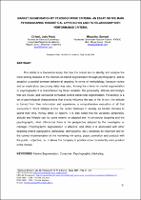| dc.creator | Ciribeli, João Paulo | |
| dc.creator | Miquelito, Samuel | |
| dc.date.accessioned | 2023-03-13T22:54:49Z | |
| dc.date.available | 2023-03-13T22:54:49Z | |
| dc.date.issued | 2014-12-19 | |
| dc.identifier.citation | Ciribeli, J. P. y Miquelito, S. (2014). Market segmentation by psychographic criterio: an essay on the main psychographic theoretical approaches and its relationship with performance criteria. Visión de Futuro, Revista Científica. Posadas (Misiones): UNaM. FCE. APP; 19(1), 51-64. | es_AR |
| dc.identifier.issn | 1668 – 8708 (Versión en línea) | |
| dc.identifier.other | VF-250 | |
| dc.identifier.uri | https://hdl.handle.net/20.500.12219/4663 | |
| dc.description | Fil: Ciribeli, João Paulo. Universidad Nacional de Misiones. Facultad de Ciencias Económicas; Argentina. | es_AR |
| dc.description | Fil: Miquelito, Samuel. Faculdade Governador Ozanam Coelho; Brasil. | |
| dc.description.abstract | This article is a theoretical essay that has the overall aim to identify and analyze the most striking features of the criterion of market segmentation through psychographic, and to establish a parallel between behavioral targeting. In terms of methodology, literature review and an exploratory (secondary data) was used. Among the criteria for market segmentation or psychographic it is characterized by three variables: the personality, attitude and lifestyle that are mixed (and somewhat confused) criteria behavioral segmentation. Personality is a set of psychological characteristics that directly influence the way of life. In turn, the attitude is formed from their information and experience, a comprehensive evaluation of all that surrounds it. Since lifestyle is how the person behaves in society, as he/she chooses to spend their time, money, effort, or options. It is also noted that the variables: personality, attitude and lifestyle can (to some extent) be adopted both in behavioral targeting and the psychographic, what differences them is the perspective adopted by the investigator or manager. Psychographic segmentation is affective, and when it is associated with otherv targeting criteria (geographic, behavioral, demographic, etc.), becomes an important tool for the correct implementation of the marketing mix (price, place, promotion and product) with the public - objective, i.e., it allows the company to position more consistently one’s producto in the market. | es_AR |
| dc.format | application/pdf | |
| dc.format.extent | 138 KB | |
| dc.language.iso | eng | es_AR |
| dc.publisher | Universidad Nacional de Misiones. Facultad de Ciencias Económicas. Programa de Posgrado en Administración | es_AR |
| dc.relation | info:eu-repo/semantics/altIdentifier/urn/https://visiondefuturo.fce.unam.edu.ar/index.php/visiondefuturo/article/view/544/412 | |
| dc.rights | info:eu-repo/semantics/openAccess | |
| dc.subject | Market segmentation | es_AR |
| dc.subject | Consumer | es_AR |
| dc.subject | Psychographic | es_AR |
| dc.subject | Marketing | es_AR |
| dc.title | Market segmentation by psychographic criterio : an essay on the main psychographic theoretical approaches and its relationship with performance criteria | es_AR |
| dc.type | info:eu-repo/semantics/article | es_AR |
| dc.type | info:ar-repo/semantics/artículo | |
| dc.type | info:eu-repo/semantics/publishedVersion | |



